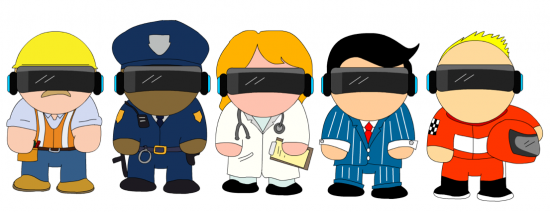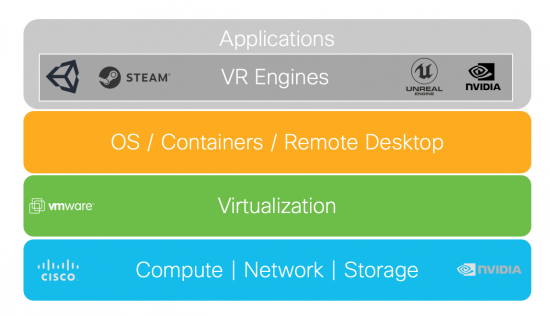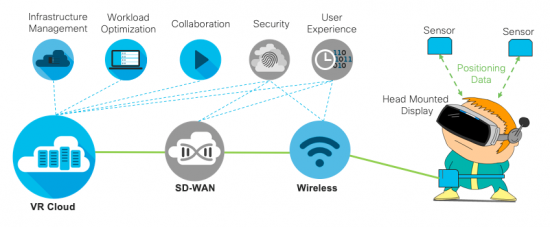































Virtual|Reality|(VR) is starting to disrupt all manner of industries. From Construction to Healthcare, Financial Services to Formula One. It's one of the cooler technology innovations to happen of late. The value of VR is clearly measurable, with early adopters gaining competitive advantage and creating new revenue streams.
 VR Vertical Opportunities and Use Cases
VR Vertical Opportunities and Use Cases
The opportunities that Immersive Reality presents are disruptive to the Enterprise business, enabling early adopters to deliver complex products in a fraction of the time, close sales faster, increase revenue and reduce costs.
For example, imagine if you are a construction company and your architects and engineers can collaborate in virtual reality using a digital twin. You can walk together around the digital building before its built, and make modifications. Why not take potential buyers for a tour of the building to sell space before it's built. A good example of this is NVidia Holodeck. Take a look at this holodeck video to blow your virtual socks off.
VR is essentially a 3d immersive experience. You pop on a Head Mounted Display (HMD) and you get a 360 degree field of view of the virtual world created. Sensors around you map exactly where you are looking and ensure your view matches your movements. It's all very clever. The experience you get depends really on how much processing power you have to hand. The more processing power in the Graphical Processing Unit (GPU) the more realistic your experience can be. VR incorporates mainly auditory and visual feedback, but may also allow other types of sensory feedback like haptic.
Most VR solutions around today have the GPU located in the edge device. Your PC, PlayStation, Xbox or phone. To Make them consumer affordable the GPUs are not that powerful as high end GPUs used for things like Artificial Intelligence and Machine Learning. High end GPUs can cost thousands of pounds/dollars/euros, making the overall edge device very expensive. That makes it too expensive for the consumer but maybe not for an Enterprise. When you start to scale a VR solution it starts to become very expensive, not just the hardware cost but also managing it. Imagine having 100 headsets distributed around the Enterprise.
So, when you look at cloud economics, it makes sense to centralise the compute and those GPUs into a cloud and just have the headset at the remote site connected to a network.
When someone puts on a HMD the cloud allocates the resources it needs in real time. At other times those GPUs can be used for other tasks or applications in the workflow.
Collaborative VR refers to multiple participants seamlessly working together in the same VR space. They may be walking around a digital building that's not been built yet, or working on car design. Being in the VR space is far more effective that sharing documents or being on a video call. The key here is that inserting VR into traditional industry workflows increases collaboration, reduce design time, production timelines and costs. It also reduces costly mistakes and ensures you are delivering to the customers expectations.
Ok, Head Mounted Displays (HMD) today can be quite "clunky" looking. They are not quite a fashion accessory yet. But they are changing. Like the GPU, the processing power/capabilities of the HMD determines how immersive the VR experience is. You go from lower end HMDs like the Google Cardboard to high end HTV Vive or Oculus. Over the next few years the HMDs will reduce the "clunk" and become more glasses like. This will help with the adoption and habitual use of VR.
The habitual use of VR relies on its proven value in any given activity or workflow. The younger generation will no doubt have VR as part of their daily life. The gamification of things like training are second nature to many these day and an effective way to learn and engage. Take for example the VR training experience used at Kentucky Fried Chicken. Industry will adopt VR because it makes workflows more productive and work life easier.

Habitual VR
Cisco and ebb3 have teamed together to build the Cisco VR Private Cloud.
Ebb3 are experts in the VR and 3D industry and have developed a VR software platform for the delivery of VR from the cloud. Coupled with Cisco infrastructure we have the first Enterprise VR Cloud in the industry.
 Centralized VR Cloud Delivered Across the Network
Centralized VR Cloud Delivered Across the Network
The VR Cloud is based on HyperFlex, Cisco's Hyperconverged Infrastructure (HCI). This provides highly scalable compute and networking capabilities including the latest generation of nVidia Tesla v100 GPUs. An integral component of HCI is the virtualisation layer, in this instance it is provided by VMware ESX. The next abstraction is the Operating systems, containers and remote desktops delivering control plane and VR sessions to remote users. The next abstraction are the VR engines. You have a choice of leading VR engines such as Unity, Unreal and OpenVR and Holodeck.
The VR cloud is not dedicated just to VR though. Most companies will be using a mix of other applications like 3D modelling, rendering, CAD, AI and ML. The platform caters for all of these applications and workloads.
 Cisco ebb3 Virtual Reality Private Cloud Architecture
Cisco ebb3 Virtual Reality Private Cloud Architecture
The cloud architecture is available today and deliverable via our partner ebb3. But the cloud is only part of the overall solution. To make the platform Enterprise grade there are a number of other services under development and integration.
 Enterprise Services Required for Enterprise VR Delivery
Enterprise Services Required for Enterprise VR Delivery
The VR cloud will be running multiple application and workload types so you need infrastructure management and workload automation to ensure that each workload gets sized appropriately and gets the resources it requires, such as a dedicated GPU. Not everyone will engage in a VR space with a HMD, they may use their phone or video endpoint. For that to happen you need integration into collaboration tools like Google Hangouts or Cisco Webex. Security is another important solution, confirming the identity of those using the system and those who have access to the data.
Finally, we come to user experience. With VR you have specific bandwidth and latency thresholds that need to be met to ensure a consistent experience. Keeping low and consistent Latency between the GPU and HMD is crucial in order to avoid sensorial misalignment, or as its more commonly known as "Motion Sickness". If there is a delay in when you move your head and the response of virtual reality landscape you are in, then you may experience disorientation. To avoid this, we can set a policy in the SD-WAN to ensue the VR session gets the network resources its needs using application intelligence, real-time monitoring and traffic management. Equally an Application Performance Management (APM) solution could measure the user experience and signal the WAN to make changes if the user experience deteriorates.
Want to see it in action? We have a VR demo facility available at Cisco Bedfont Lakes office in the UK and look out for us at CiscoLive and DevNet Create.
Virtual Reality is here and if you are not already using or working with VR you will be soon. Cisco and ebb3 are leading the charge with VR, transforming businesses, and making Enterprise Virtual Reality a Practical Reality.
For more information please contact [email protected]


We'd love to hear what you think. Ask a question or leave a comment below.
And stay connected with Cisco DevNet on social!
Twitter @CiscoDevNet | Facebook | LinkedIn
Visit the new Developer Video Channel
 Tags quentes :
Destaque
Realidade virtual
Tags quentes :
Destaque
Realidade virtual